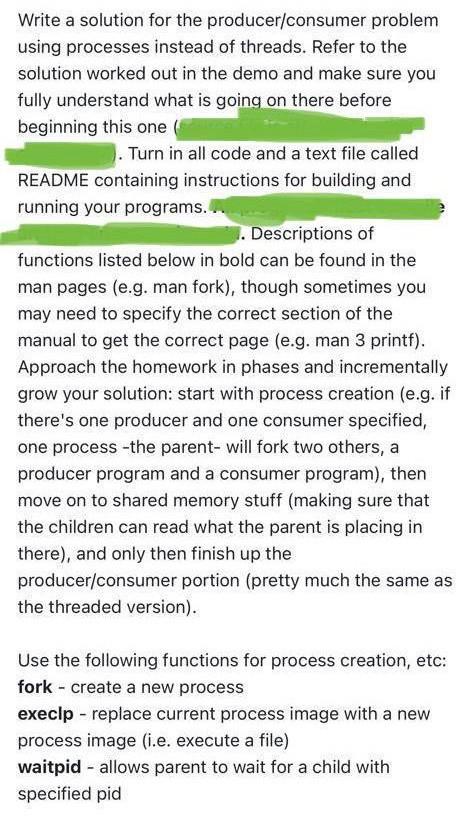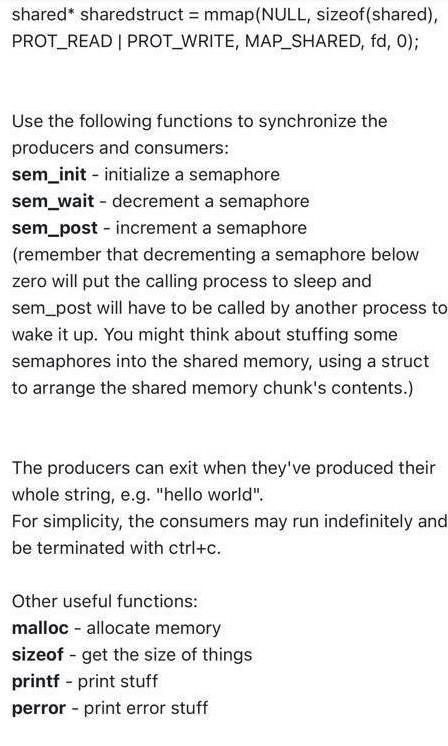Answered step by step
Verified Expert Solution
Question
1 Approved Answer
Write a solution for the producer/consumer problem using processes instead of threads. Refer to the solution worked out in the demo and make sure you



Write a solution for the producer/consumer problem using processes instead of threads. Refer to the solution worked out in the demo and make sure you fully understand what is going on there before beginning this one 1. Turn in all code and a text file called README containing instructions for building and running your programs. Descriptions of functions listed below in bold can be found in the man pages (e.g. man fork), though sometimes you may need to specify the correct section of the manual to get the correct page (e.g. man 3 printf). Approach the homework in phases and incrementally grow your solution: start with process creation (e.g. if there's one producer and one consumer specified, one process -the parent- will fork two others, a producer program and a consumer program), then move on to shared memory stuff (making sure that the children can read what the parent is placing in there), and only then finish up the producer/consumer portion (pretty much the same as the threaded version). Use the following functions for process creation, etc: fork - create a new process execlp - replace current process image with a new process image (i.e. execute a file) waitpid - allows parent to wait for a child with specified pid Use the following functions for sharing stuff between processes: shm_open - create a named chunk of shared memory ftruncate - to change the size of the named chunk of shared memory mmap - to map the shared memory chunk into current process' address space Example: Let's say you want to share a struct, like: typedef struct shared{ int some_int_to_share; int some_other_int_to_share; }shared; In the parent process (the one that starts everything): int fd = shm_open("prodconshare", O_CREAT|| O_RDWR, S_IRUSR I S_IWUSR); ftruncate(fd, sizeof(shared)); shared sharedstruct = mmap(NULL, sizeof(shared), PROT_READ PROT_WRITE, MAP_SHARED, fd, 0); In the child process it is similar, but the child process would not create the named chunk if it doesn't exist and the child process has no need to resize the chunk (so, no ftruncate): int fd = shm_open("prodconshare", O_RDWR, S_IRUSR | S_IWUSR); shared* sharedstruct = mmap(NULL, sizeof(shar shared* sharedstruct = mmap(NULL, sizeof(shared), PROT_READ | PROT_WRITE, MAP_SHARED, fd, 0); Use the following functions to synchronize the producers and consumers: sem_init - initialize a semaphore sem_wait - decrement a semaphore sem_post-increment a semaphore (remember that decrementing a semaphore below zero will put the calling process to sleep and sem_post will have to be called by another process to wake it up. You might think about stuffing some semaphores into the shared memory, using a struct to arrange the shared memory chunk's contents.) The producers can exit when they've produced their whole string, e.g. "hello world". For simplicity, the consumers may run indefinitely and be terminated with ctrl+c. Other useful functions: malloc - allocate memory sizeof - get the size of things printf - print stuff perror - print error stuff
Step by Step Solution
There are 3 Steps involved in it
Step: 1

Get Instant Access to Expert-Tailored Solutions
See step-by-step solutions with expert insights and AI powered tools for academic success
Step: 2

Step: 3

Ace Your Homework with AI
Get the answers you need in no time with our AI-driven, step-by-step assistance
Get Started


